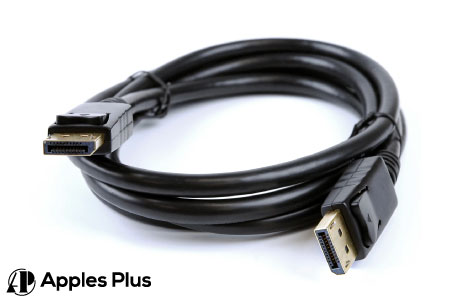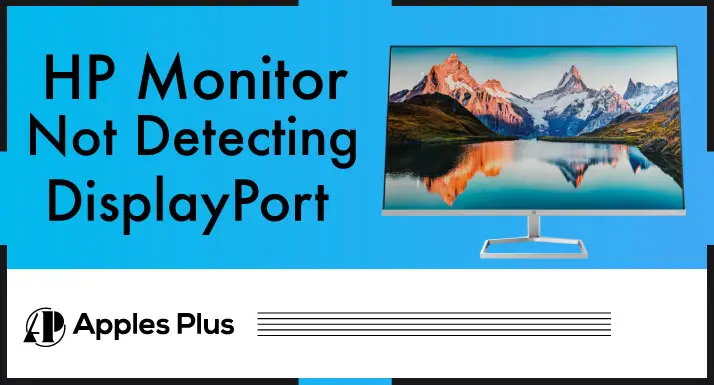In today’s digital world, monitors have become essential to our computer systems. However, it can be frustrating when your HP monitor fails to detect a DisplayPort connection, preventing you from using your monitor as intended.
Various factors, including faulty hardware, driver issues, and incompatible monitor settings, can cause this issue.
In this blog post, we will explore the possible causes of the HP monitor not detecting the DisplayPort issue and discuss the troubleshooting steps you can take to resolve the issue and get your monitor working as intended.
Why HP Monitor Not Detecting DisplayPort?
There are several reasons why an HP monitor may not be detecting the DisplayPort connection:
1. Faulty Cable:

A faulty cable is a cable that is damaged or not functioning correctly. In the case of a DisplayPort cable, there are several ways that it could be faulty:
- If the cable has been bent, twisted, or pulled too hard, it can damage the internal wiring or connectors. It can cause the cable to lose its ability to transmit the signal properly.
- If the connectors on the cable are loose or damaged, they may be unable to connect with the monitor or graphics card properly. It can result in a poor or non-existent signal.
- DisplayPort cables have 20 pins inside the connector, and if any of these pins are bent or broken, the cable may not be able to transmit the signal properly.
- Not all cables are created equal, and some lower-quality cables may not be able to handle the bandwidth required for DisplayPort signals. It can result in a poor or unstable signal.
When a DisplayPort cable is faulty, it can prevent the monitor from detecting the signal or cause the signal to be poor or unstable.
If you suspect the cable is the issue, try using a different cable to see if that resolves the problem. If the issue persists, another underlying issue may require further investigation.
2. Incorrect Input Selected:
Incorrect input selection is another common reason an HP monitor may not detect the DisplayPort connection. Here are some details on what this means:
Modern monitors have multiple input sources, such as VGA, HDMI, and DisplayPort. If you have multiple input sources connected to your monitor, you must select the correct input source for the DisplayPort connection. If the wrong input source is selected, the monitor cannot detect the DisplayPort signal.
You will typically need to use the monitor’s built-in menu system to select the correct input source on your monitor. Here’s how to do it:
- Turn on your monitor and computer.
- Press the button on the monitor to open the menu.
- Use the arrow buttons on the monitor to navigate to the input source option.
- Select the DisplayPort option from the available input sources.
- Save your changes and exit the menu.
If you need help determining which input source to select, consult the documentation that came with your monitor or contact the manufacturer’s support team for assistance.
Sometimes, your monitor may be set to detect the input source automatically. If this is the case and the monitor still does not detect the DisplayPort connection, you may need to select the input source to troubleshoot the issue manually.
3. Driver Issues:
In computing, a driver is a software program that enables the operating system to communicate with the hardware devices attached to the computer. It is a translator between the hardware and the operating system, allowing them to work together. Without drivers, the operating system would be unable to recognize or interact with the hardware devices.
Driver issues occur when the installed driver is outdated, corrupt, or incompatible with the hardware or operating system. It can lead to problems such as malfunction, system instability, or even complete system crashes.
Some common symptoms of driver issues include:
- The hardware device may not be recognized or detected by the operating system or be shown as an unknown device.
- The device may not function correctly or be unable to perform its intended functions.
- Outdated or incompatible drivers can cause system crashes or blue screens of death (BSOD).
- Driver issues can cause error messages, such as “device driver not found” or “device driver corrupted.”
- Outdated or incompatible drivers can cause slow performance, stuttering, or lag.
To resolve the driver issues, it is important to identify the problematic driver and update or reinstall it. It can be done through the device manager in the operating system or by downloading the latest driver from the manufacturer’s website.
It is also important to ensure the driver is compatible with the hardware and the operating system. Keeping drivers up-to-date can help prevent driver issues and ensure smooth and efficient system operation.
4. Monitor Compatibility
Monitor compatibility refers to the ability of a monitor to work with specific hardware and software components, such as graphics cards, operating systems, and display connectors.
Compatibility issues can arise when these components must be correctly matched or configured, leading to problems such as incorrect resolutions, display artifacts, or even hardware damage.
Several factors can affect monitor compatibility, including:
- Monitors have specific native resolutions and refresh rates designed to work with them. If properly configured or matched with the graphics card, the image quality may improve, or the monitor may display an image.
- Graphics cards have different output connectors like DisplayPort, HDMI, and VGA. If the monitor does not have a compatible input connector, an adapter or converter may be needed to connect the two devices.
- Some monitors may not be compatible with certain operating systems or require specific drivers to function properly.
- Different video signals, analog and digital signals, can affect monitor compatibility. Some monitors may not support certain video signal types or require specific configurations to work properly.
To ensure monitor compatibility, it is important to research and verifies the monitor’s specifications and the hardware and software components it will be connected to. It can help prevent compatibility issues and ensure the monitor performs as expected.
It is also important to keep all drivers and firmware up-to-date to ensure compatibility with the latest hardware and software components.
5. Faulty Graphics Card:
An issue with your graphics card may be preventing the monitor from detecting the DisplayPort signal. Try connecting the monitor to a different computer or using a different monitor to see if the issue persists.
A faulty graphics card can cause display issues in several ways:
- Graphics cards generate a lot of heat; if they overheat, they can malfunction or even fail. Symptoms of overheating can include artifacts, screen flickering, and system crashes.
- Graphics card drivers can become outdated or corrupted, leading to display issues such as incorrect resolutions, screen tearing, or complete failure to display any image.
- Graphics cards can fail due to manufacturing defects, physical damage, or wear and tear. Symptoms of hardware failure can include incorrect colors, distorted images, and complete failure to display any image.
6. Monitor Settings:
Check the monitor settings to ensure it is set up to receive input through the DisplayPort. Some monitors have specific settings that must be configured to work with DisplayPort.
- If the monitor’s resolution is not set to match the graphics card’s output resolution, the image quality may suffer, or the monitor may not display any image.
- If the monitor’s refresh rate is not properly configured, it can cause display issues such as tearing or stuttering.
- If the monitor’s color settings are incorrect or misconfigured, it can lead to incorrect colors or distorted images.
7. Faulty Hardware
Faulty hardware refers to computer components not functioning properly due to physical damage, wear, and tear, or manufacturing defects. It can result in various problems, from minor glitches and errors to complete hardware failure.
Some examples of faulty hardware include:
- HDDs can fail due to physical damage, such as drops or impacts, or wear and tear over time. Symptoms of HDD failure can include slow performance, frequent crashes, and data loss.
- RAM modules can fail due to overheating, electrical surges, or manufacturing defects. Symptoms of RAM failure can include system crashes, blue screens of death (BSOD), and memory-related errors.
- CPUs can fail due to overheating, voltage fluctuations, or manufacturing defects. Symptoms of CPU failure can include system crashes, slow performance, and hardware-related errors.
- Power supplies can fail due to electrical surges, overheating, or manufacturing defects. Symptoms of power supply failure can include system crashes, hardware-related errors, and failure to power on.
- Graphics cards can fail due to overheating, manufacturing defects, or damage from power surges. Symptoms of graphics card failure can include screen artifacts, system crashes, and hardware-related errors.
To diagnose and fix faulty hardware issues, it is important to identify the problematic component and either repair or replace it. It can often be done through hardware diagnostics tools, such as built-in system tests or third-party software.
Taking precautions to prevent hardware damage is important, such as using surge protectors and keeping components properly cooled and ventilated. Regular hardware maintenance, such as cleaning and inspection, can also help to prevent and identify potential hardware issues.
Conclusion
In conclusion, an HP monitor not detecting a DisplayPort connection can be a frustrating experience that can impact your work or entertainment. However, with proper troubleshooting steps, this issue can often be resolved.
By identifying the underlying cause of the problem, such as faulty hardware, driver issues, or monitor settings, and taking the appropriate steps to address the issue, you can restore your HP monitor to full functionality.
We hope this discussion has provided valuable insights and solutions to help you resolve DisplayPort issues with your HP monitor.

Meet Harry, the author of Apples Plus! Harry is a highly skilled electronic engineer passionate about testing and reviewing tech products like monitors and soundbars. With years of experience in the industry, Harry has developed a keen eye for detail and an in-depth understanding of the latest tech trends and developments.


